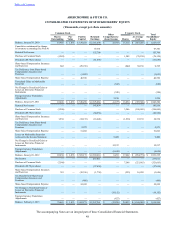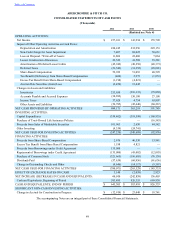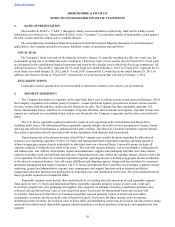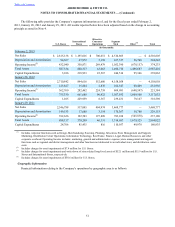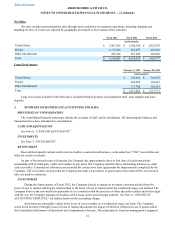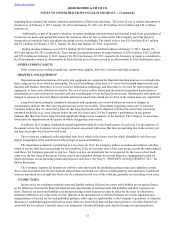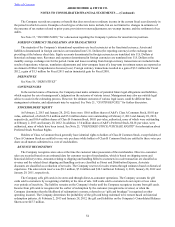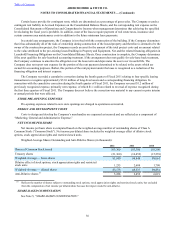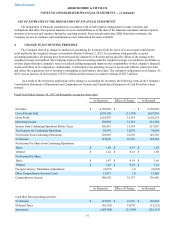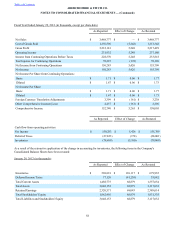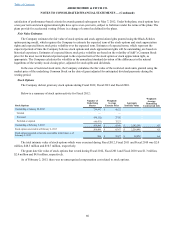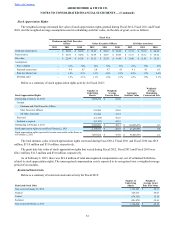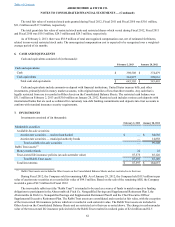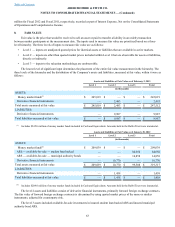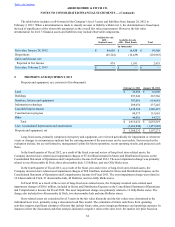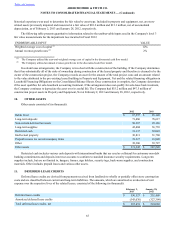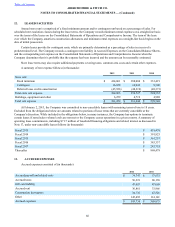Abercrombie & Fitch 2013 Annual Report Download - page 56
Download and view the complete annual report
Please find page 56 of the 2013 Abercrombie & Fitch annual report below. You can navigate through the pages in the report by either clicking on the pages listed below, or by using the keyword search tool below to find specific information within the annual report.
56
Certain leases provide for contingent rents, which are determined as a percentage of gross sales. The Company records a
contingent rent liability in Accrued Expenses on the Consolidated Balance Sheets, and the corresponding rent expense on the
Consolidated Statements of Operations and Comprehensive Income when management determines that achieving the specified
levels during the fiscal year is probable. In addition, most of the leases require payment of real estate taxes, insurance and
certain common area maintenance costs in addition to the future minimum lease payments.
In certain lease arrangements, the Company is involved with the construction of the building. If the Company determines
that it has substantially all of the risks of ownership during construction of the leased property and therefore is deemed to be the
owner of the construction project, the Company records an asset for the amount of the total project costs and an amount related
to the value attributed to the pre-existing leased building in Property and Equipment, Net and the related financing obligation in
Leasehold Financing Obligations on the Consolidated Balance Sheets. Once construction is complete, the Company determines
if the asset qualifies for sale-leaseback accounting treatment. If the arrangement does not qualify for sale-lease back treatment,
the Company continues to amortize the obligation over the lease term and depreciates the asset over its useful life. The
Company does not report rent expense for the portion of the rent payment determined to be related to the assets which are
owned for accounting purposes. Rather, this portion of the rent payment under the lease is recognized as a reduction of the
financing obligation and interest expense.
The Company recorded a cumulative correction during the fourth quarter of Fiscal 2011 relating to four specific leasing
transactions to recognize approximately $33.0 million of long-lived assets and a corresponding financing obligation. In
connection with the cumulative correction during the fourth quarter of Fiscal 2011, the Company reversed $1.2 million of
previously recognized expense, primarily rent expense, of which $1.1 million related to reversal of expense recognized during
the first three quarters of Fiscal 2011. The Company does not believe the correction was material to any current or prior interim
or annual periods that were affected.
STORE PRE-OPENING EXPENSES
Pre-opening expenses related to new store openings are charged to operations as incurred.
DESIGN AND DEVELOPMENT COSTS
Costs to design and develop the Company’s merchandise are expensed as incurred and are reflected as a component of
“Marketing, General and Administrative Expense.”
NET INCOME PER SHARE
Net income per basic share is computed based on the weighted-average number of outstanding shares of Class A
Common Stock (“Common Stock”). Net income per diluted share includes the weighted-average effect of dilutive stock
options, stock appreciation rights and restricted stock units.
Weighted-Average Shares Outstanding and Anti-Dilutive Shares (in thousands):
2012 2011 2010
Shares of Common Stock issued 103,300 103,300 103,300
Treasury shares (21,360)(16,452)(15,239)
Weighted-Average — basic shares 81,940 86,848 88,061
Dilutive effect of stock options, stock appreciation rights and restricted
stock units 1,235 2,689 1,790
Weighted-Average — diluted shares 83,175 89,537 89,851
Anti-Dilutive shares (1) 5,228 2,452 6,019
(1) Reflects the number of shares subject to outstanding stock options, stock appreciation rights and restricted stock units, but excluded
from the computation of net income per diluted share because the impact would be anti-dilutive.
SHARE-BASED COMPENSATION
See Note 5, “SHARE-BASED COMPENSATION.”
Table of Contents ABERCROMBIE & FITCH CO.
NOTES TO CONSOLIDATED FINANCIAL STATEMENTS — (Continued)




